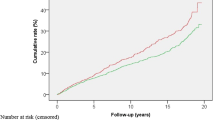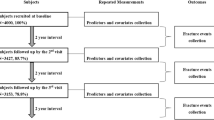Abstract
Summary
This study of postmenopausal women (n = 2,928) with an eight-year follow-up revealed that impairment in functional status associated with the increased fracture risk. The standing-on-one-foot and grip strength tests and a question about self-assessed ability to move can be used to identify women with a high risk of suffering a fracture.
Introduction
Poor functional status has pointed to associate with injurious falls and consequent fractures. Our aim was to define association between functional capacity and fractures.
Methods
This study was based on the Osteoporosis Risk Factor and Prevention Study (OSTPRE). A total of 2,928 postmenopausal women took part in the functional capacity and muscle strength tests. The duration of fracture follow-up varied from 6.43 to 9.86 (mean 8.37) years and the first fracture was the end-point event for the statistical analyses. All analyses were done with Cox-regression.
Results
A total of 261 end-point fractures occurred. In multivariate analysis the inability to stand-on-one-foot for 10 seconds increased the risk of hip fracture (hazard ratio with 95% CI) 9.11-fold (1.98–42.00). Decreased grip strength associated with 1.05-fold (1.01–1.09) increased risk of hip fractures. Low leg extension strength associated with 1.02-fold (1.00–1.03) higher risk for all fractures. The self-assessed ability to walk less than 100 meters at baseline increased the risk of ankle 2.36-fold (1.10–5.08), hip 11.57-fold (2.73–49.15) and clinical vertebral fractures 3.85-fold (1.45–10.22).
Conclusion
According to these results the standing-on-one-foot less than 10 seconds, grip strength and a question about ability to walk less than 100 meters may help to predict postmenopausal fractures.

Similar content being viewed by others
References
Stone KL, Seeley DG, Lui LY, Cauley JA, Ensrud K, Browner WS, Nevitt MC, Cummings SR; Osteoporotic Fractures Research Group (2003) BMD at multiple sites and risk of fracture of multiple types: long-term results from the Study of Osteoporotic Fractures. J Bone Miner Res 18(11):1947–1954 Nov
Seeman E (2002) Pathogenesis of bone fragility in women and men. Lancet 359(9320):1841–5180 May 25
De Laet C, Oden A, Johansson H, Johnell O, Jonsson B, Kanis JA (2005) The impact of the use of multiple risk indicators for fracture on case-finding strategies: a mathematical approach. Osteoporos Int 16(3):313–318 Mar
Kanis JA, Borgstrom E, De Laet C, Johansson H, Johnell O, Jonsson B, Oden A, Zethraeus N, Pfleger B, Khaltaev N (2005) Assessment of fracture risk. Osteoporos Int 16(6):581–589 Jun
Dargent-Molina P, Favier F, Grandjean H, Baudoin C, Schott AM, Hausherr E, Meunier PJ, Breart G (1996) Fall-related factors and risk of hip fracture: the EPIDOS prospective study. Lancet 348(9021):145–149 Jul 20
Nguyen ND, Pongchaiyakul C, Center JR, Eisman JA, Nguyen TV (2005) Identification of high-risk individuals for hip fracture: a 14-year prospective study. J Bone Miner Res 20(11):1921–1928 Nov
Guralnik JM, Winograd CH (1994) Physical performance measures in the assessment of older persons. Aging (Milano) 6(5):303–305 Oct
Guralnik JM, Simonsick EM, Ferrucci L, Glynn RJ, Berkman LF, Blazer DG, Scherr PA, Wallace RB (1994) A short physical performance battery assessing lower extremity function: association with self-reported disability and prediction of mortality and nursing home admission. J Gerontol 49(2):M85–M94 Mar
Tinetti ME, Speechley M, Ginter SF (1988) Risk factors for falls among elderly persons living in the community. N Engl J Med 319(26):1701–1707 Dec 29
Nevitt MC, Cummings SR, Kidd S, Black D (1989) Risk factors for recurrent nonsyncopal falls. A prospective study. JAMA 261(18):2663–2668 May 12
Korpelainen R, Korpelainen J, Heikkinen J, Vaananen K, Keinanen-Kiukaanniemi S (2006) Lifelong risk factors for osteoporosis and fractures in elderly women with low body mass index-a population-based study. Bone 39(2):385–391 Aug
Overstall PW, Exton-Smith AN, Imms FJ, Johnson AL (1977) Falls in the elderly related to postural imbalance. Br Med J 1(6056):261–264 Jan 29
Vellas BJ, Wayne SJ, Romero L, Baumgartner RN, Rubenstein LZ, Garry PJ (1997) One-leg balance is an important predictor of injurious falls in older persons. J Am Geriatr Soc 45(6):735–738 Jun
Gerdhem P, Ringsberg KA, Akesson K, Obrant KJ (2005) Clinical history and biologic age predicted falls better than objective functional tests. J Clin Epidemiol 58(3):226–232 Mar
Albrand G, Munoz F, Sornay-Rendu E, DuBoeuf F, Delmas PD (2003) Independent predictors of all osteoporosis-related fractures in healthy postmenopausal women: the OFELY study. Bone 32(1):78–85 Jan
Rantanen T, Guralnik JM, Foley D, Masaki K, Leveille S, Curb JD, White L (1999) Midlife hand grip strength as a predictor of old age disability. JAMA 281(6):558–560 Feb 10
Syddall H, Cooper C, Martin F, Briggs R, Aihie Sayer A (2003) Is grip strength a useful single marker of frailty? Age Ageing 32(6):650–656 Nov
Sirola J, Rikkonen T, Tuppurainen M, Jurvelin JS, Kroger H (2006) Association of grip strength change with menopausal bone loss and related fractures: a population-based follow-up study. Calcif Tissue Int 78(4):218–226 Apr
Samelson EJ, Hannan MT, Zhang Y, Genant HK, Felson DT, Kiel DP (2006) Incidence and risk factors for vertebral fracture in women and men: 25-year follow-up results from the population-based Framingham study. J Bone Miner Res 21(8):1207–1214 Aug
Robbins J, Aragaki AK, Kooperberg C, Watts N, Wactawski-Wende J, Jackson RD, LeBoff MS, Lewis CE, Chen Z, Stefanick ML, Cauley J (2007) Factors associated with 5-year risk of hip fracture in postmenopausal women. JAMA 298(20):2389–2398 Nov 28
Merkies IS, Schmitz PI, Samijn JP, Meché FG, Toyka KV, van Doorn PA (2000) Assessing grip strength in healthy individuals and patients with immune-mediated polyneuropathies. Muscle Nerve 23(9):1393–1401 Sep
Robertson S, Frost H, Doll H, O’Connor JJ (1998) Leg extensor power and quadriceps strength: an assessment of repeatability in patients with osteoarthritic knees. Clin Rehabil 12(2):120–126 Apr
Alaranta H, Hurri H, Heliövaara M, Soukka A, Harju R (1994) Non-dynamometric trunk performance tests: reliability and normative data. Scand J Rehabil Med 26(4):211–215 Dec
Suni JH, Oja P, Laukkanen RT, Miilunpalo SI, Pasanen ME, Vuori IM, Vartiainen TM, Bös K (1996) Health-related fitness test battery for adults: aspects of reliability. Arch Phys Med Rehabil 77(4):399–405 Apr
Honkanen K, Honkanen R, Heikkinen L, Kröger H, Saarikoski S (1999) Validity of self-reports of fractures in perimenopausal women. Am J Epidemiol 150(5):511–516 Sep 1
Sirola J, Tuppurainen M, Honkanen R, Jurvelin JS, Kroger H (2005) Associations between grip strength change and axial postmenopausal bone loss-a 10-year population-based follow-up study. Osteoporos Int 16(12):1841–1848 Dec
Lord SR, McLean D, Stathers G (1992) Physiological factors associated with injurious falls in older people living in the community. Gerontology 38(6):338–346
Hu MH, Woollacott MH (1994) Multisensory training of standing balance in older adults: I. Postural stability and one-leg stance balance. J Gerontol 49(2):M52–M61Mar
Feskanich D, Willett W, Colditz G (2002) Walking and leisure-time activity and risk of hip fracture in postmenopausal women. JAMA 288(18):2300–2306 Nov 13
Sinaki M, Itoi E, Wahner HW, Wollan P, Gelzcer R, Mullan BP, Collins DA, Hodgson SF (2002) Stronger back muscles reduce the incidence of vertebral fractures: a prospective 10 year follow-up of postmenopausal women. Bone 30(6):836–841 Jun
Sirola J, Rikkonen T, Kroger H, Honkanen R, Tuppurainen M, Airaksinen O, Saarikoski S (2004) Factors related to postmenopausal muscle performance: a cross-sectional population-based study. Eur J Appl Physiol 93(1–2):102–107 Oct
Campbell AJ, Robertson MC, Gardner MM, Norton RN, Tilyard MW, Buchner DM (1997) Randomised controlled trial of a general practice programme of home based exercise to prevent falls in elderly women. BMJ 315(7115):1065–1069 Oct 25
Day L, Fildes B, Gordon I, Fitzharris M, Flamer H, Lord S (2002) Randomised factorial trial of falls prevention among older people living in their own homes. BMJ 325(7356):128 Jul 20
Tinetti ME (2003) Preventing falls in elderly persons. N Engl J Med 348(1):42–49 Jan 2
Chang JT, Morton SC, Rubenstein LZ, Mojica WA, Maglione M, Suttorp MJ, Roth EA, Shekelle PG (2004) Interventions for the prevention of falls in older adults: systematic review and meta-analysis of randomised clinical trials. BMJ 328(7441):680 Mar 20
Heinonen A, Kannus P, Sievanen H, Oja P, Pasanen M, Rinne M, Uusi-Rasi K, Vuori I (1996) Randomised controlled trial of effect of high impact exercise on selected risk factors for osteoporotic fractures. Lancet 348(9038):1343–1347 Nov 16
Carter ND, Kannus P, Khan KM (2001) Exercise in the prevention of falls in older people: a systematic literature review examining the rationale and the evidence. Sports Med 31(6):427–438
Marigold DS, Eng JJ, Dawson AS, Inglis JT, Harris JE, Gylfadottir S (2005) Exercise leads to faster postural reflexes, improved balance and mobility, and fewer falls in older persons with chronic stroke. J Am Geriatr Soc 53(3):416–423 Mar
Luukinen H, Herala M, Koski K, Honkanen R, Laippala P, Kivela SL (2000) Fracture risk associated with a fall according to type of fall among the elderly. Osteoporos Int 11(7):631–634
De Laet C, Kanis JA, Oden A, Johanson H, Johnell O, Delmas P, Eisman JA, Kroger H, Fujiwara S, Garnero P, McCloskey EV, Mellstrom D, Melton LJ 3rd, Meunier PJ, Pols HA, Reeve J, Silman A, Tenenhouse A (2005) Body mass index as a predictor of fracture risk: a meta-analysis. Osteoporos Int 16(11):1330–1338 Nov
Lord SR, Ward JA (1994) Age-associated differences in sensori-motor function and balance in community dwelling women. Age Ageing 23(6):452–460 Nov
Sirola J, Rikkonen T (2005) Muscle performance after the menopause. J Br Menopause Soc 11(2):45–50 Jun
Lord SR, Ward JA (1994) Age-associated differences in sensori-motor function and balance in community dwelling women. Age Ageing 23(6):452–460 Nov
Gauchard GC, Jeandel C, Tessier A, Perrin PP (1999) Beneficial effect of proprioceptive physical activities on balance control in elderly human subjects. Neurosci Lett 273(2):81–84 Oct 1
Menz HB, Morris ME, Lord SR (2005) Foot and ankle characteristics associated with impaired balance and functional ability in older people. J Gerontol A Biol Sci Med Sci 60(12):1546–1552 Dec
Balzini L, Vannucchi L, Benvenuti F, Benucci M, Monni M, Cappozzo A, Stanhope SJ (2003) Clinical characteristics of flexed posture in elderly women. J Am Geriatr Soc 51(10):1419–1426 Oct
Kanis JA, Johnell O, Oden A, De Laet C, Jonsson B, Dawson A (2002) Ten-year risk of osteoporotic fracture and the effect of risk factors on screening strategies. Bone 30(1):251–258 Jan
Valtola A, Honkanen R, Kroger H, Tuppurainen M, Saarikoski S, Alhava E (2002) Lifestyle and other factors predict ankle fractures in perimenopausal women: a population-based prospective cohort study. Bone 30(1):238–242 Jan
Seeley DG, Kelsey J, Jergas M, Nevitt MC (1996) Predictors of ankle and foot fractures in older women. The Study of Osteoporotic Fractures Research Group. J Bone Miner Res 11(9):1347–1355 Sep
Nevitt MS, Cummings SR (1993) Type of fall and risk of hip and wrist fractures: the study of osteoporotic fractures. The Study of Osteoporotic Fractures Research Group. J Am Geriatr Soc 41(11):1226–1234 Nov
Huopio J, Kroger H, Honkanen R, Saarikoski S, Alhava E (2000) Risk factors for perimenopausal fractures: a prospective study. Osteoporos Int 11(3):219–227
Acknowledgements
We thank Mr. Vesa Kiviniemi for statistical advice, Ms. Seija Oinonen for technical support and Mr. Ewen Macdonald for linguistic form check. This study was supported by the Academy of Finland grant 113999, EVO grant of the Kuopio University Hospital and the Sigrid Juselius Foundation.
Conflicts of interest
None.
Author information
Authors and Affiliations
Corresponding author
Rights and permissions
About this article
Cite this article
Kärkkäinen, M., Rikkonen, T., Kröger, H. et al. Association between functional capacity tests and fractures: An eight-year prospective population-based cohort study. Osteoporos Int 19, 1203–1210 (2008). https://doi.org/10.1007/s00198-008-0561-y
Received:
Accepted:
Published:
Issue Date:
DOI: https://doi.org/10.1007/s00198-008-0561-y




